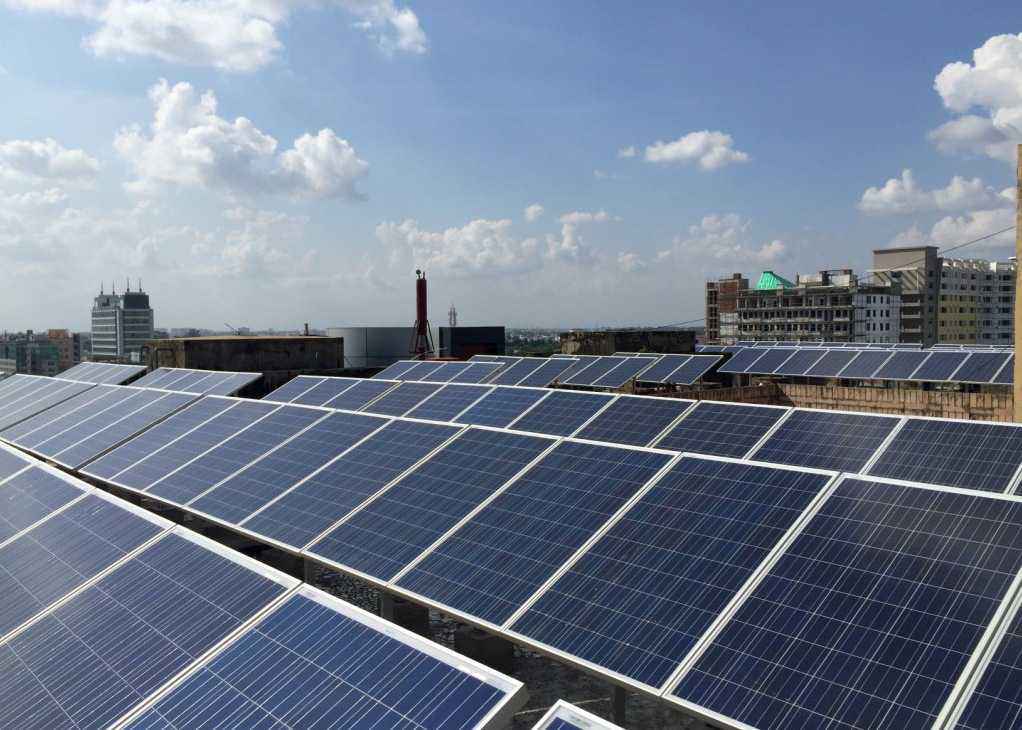Photovoltaic solar systems

Principle
Electricity can be generated by solar panels on the hotel roof, or wind turbines if conditions are favourable; this power supply is intermittent, but renewable and has very low greenhouse gas emissions. For the time being, this electricity can be sold to the national grid, at the buyback rates in effect, avoiding problems of managing intermittent supply. Southern Europe, including southern France, with a production potential of on average between 1,220 and 1,440 hours of annual solar irradiation for this territory, is suitable for the development of photovoltaic solar systems.
Photovoltaic (PV) panels can be integrated into building structure on surfaces that receive a lot of sun. Connected in series, the panels generate direct current, of variable voltage and amperage.
The direct current is converted into alternating current at the frequency required for the power grid by an inverter, with the highest possible efficiency (generally on the order of 90%).
To measure system production a meter is placed on the inverter output line, which sends the current to the grid. All electricity generated is injected into the building supply line and either consumed on site, if needed, or sold to the distributor or utility operator – today EDF in France – whence it is passed on to the nearest customer. All power production can also be sold to EDF.
Explanations
Possibilities for building integration
As explained and tested by the European HIP HIP project, there are two main ways to install PV generating systems:
1-Superimposed on top of existing structures, PV arrays do not serve as building cover or enclosure:
• sloping roof covered with discontinuous elements: the PV modules are placed above the roof, assembled on aluminium rails that are fixed to the structural supports;
• on terrace roof or waterproofed roof: modules are placed on the roof in an array assembly that sets the panels at the best angle to the sun;
• wall mounted: PV modules are fixed to a wall without shingles, using the wall surface to produce electricity;
• balcony awning or sunscreen: modules can reduce direct solar irradiation indoors and generate electricity at the same time;
• balcony or roof terrace railing.
2-Arrays integrated in building covering or envelope:
• roof integration: small panels can be fitted as part of the roof covering (PV tiles, no waterproofing is necessary) or larger panels can be built directly onto roof support beams (waterproof seams must be applied between the panels and adjacent roofing);
• shingle facing on a cement wall: PV panels can also be placed to extract energy from a facade;
• glass or wall components: translucent PV panels composed of PV cells, more or less closely spaced between two panes of glass can also constitute a wall element and filter light as well as produce electricity.
Recommendations: Demand side management (DSM) measures
When integrated photovoltaic technology is installed and connected to the grid
DSM measures must be taken in parallel in the buildings that are so equipped. In the tertiary sector, these measures are primarily:
• reduce energy consumption for lighting;
• make the most efficient use of office equipment.
Costs
The following indicators can be used to project installation output:
• 10 m² of PV modules have a capacity of 1 kWpeak.
• In southern France 1 m² of panels generates on the order of 1,200 kWh/year; in northern France 900 kWh/year.
• Estimated systems costs (equipment and labour) range from €2.3 to €3.8 / Wpeak (excluding taxes), depending on installed capacity and mode of building integration.
• The payback time for investment in a photovoltaic installation is on the order of 7 to 12 years; after this period the sale of electricity generated is a net profit for the owner.
Examples
The Hotel Ibis Porte de Clichy (Paris) has generated electricity since it opened in 2004 from 75 m² of photovoltaic panels integrated in the facade, as a sunscreen that limits heat gains in the summer. The installation has a capacity of 7.9 kWpeak, and generates an estimated 4,600 kWh/year, corresponding to 5% of anticipated electricity consumption for lighting in the 124-room establishment. The system is connected to the grid and sells all the power produced to the utility.
The installation cost €70,000 (excluding taxes) plus €26,000 (ex. taxes) in engineering costs, financed in part by ADEME Île de France and EDF.
The Solar Hotel (Paris) is equipped with photovoltaic panels installed on the building facade. These panels supply electricity for the hotel sign and exterior lighting.
The owner installed this system with the objective of 75% savings in electricity consumption. In addition, the establishment purchases only green electricity, from renewable resources.
At the Hotel des Francs (Soissons, Aisne), 284 m² of photovoltaic panels are integrated in the roof on the western side of the building, and provide 27.2 kWh/m², for an annual production of 72,488 kWh, covering 17.4% of conventionally estimated (under thermal regulations) power consumption for the building.